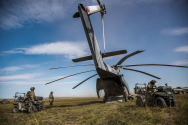I went through the article by Mandip Singh, Dean at the Indian Army's War College. Boy was I not impressed by the content.
Here is how he justifies the similarity between Russian military and the PLA:
- "Equipment homogeneity. China’s modern weaponry, including indigenously produced equipment, is basically the same as Russia’s."
- Where the hell do we even start to unpack this? Where's the Russian equivalent of the J20, Type 055, Type 052D, Type 075, PCL-181, Type 15, UAVs, etc? It's false...I'll let others debunk it even more. Granted the PLAGF has received much less focus than the PLAAF and PLAN.
- "Geopolitics. China and Russia are traditionally land-centric countries that share a long border and similar geography. There is a convergence of thinking on the roles envisaged for their militaries. Both militaries also originate in similar political systems and socio-political habits."
- No. China is significantly more invested in sea trade than Russia. Furthermore China's geography is not similar to Russian geography. No the PLA does not originate similarly to the Russian army beyond superficial comparisons of "communism".
- "Basic military strategy and doctrine. The fundamental military strategy adopted by both is ‘strategic defense’, or as the PLA’s stated military strategy calls it, ‘active defense’. Turning to perceived internal threats, both nations identify challenges from the “three evil forces” of separatism, terrorism, and religious extremism. PLA thinkers have studied Russia’s counter-insurgency strategy in Afghanistan and the Chechnya wars in great detail.[3]"
- One could easily argue that the PLA also extensively studied the US's "War on Terror". The source for this claim is from 2011...
- International military security. According to PLA sources, China and Russia have cooperated in safeguarding the international nuclear non-proliferation regime; in promoting denuclearization on the Korean Peninsula; countering terrorism; maintaining cyber security; opposing the militarization of space; and encouraged the cessation of Cold War mindsets in many countries.
- Nuclear non-proliferation is pursued by a lot more countries than just China and Russia. This list is so broad that many points were also pursued by the US and NATO as well.
Here's your claim:
"A rigid command structure that doesn't allow initiative from below. This maybe the biggest problem of the PLA today!"
I read the article and that's not a criticism they explicitly make. A lot more of the article is actually spent talking about PLA reforms tackling corruption and increasing civilian/party oversight and control.
Let's address the elephant in the room and explain why the PLA does not originate similarly to the Russian or Soviet army.
- The PLA completely changed during the 1930s after the Long March. The only resemblance to the Soviet Army retained was the presence of political officers. Even then political officers in the PLA are not involved in command and act more as instructors involved in political education and morale.
- It is important to note that the KMT were more influenced by the German military and IJA than the Soviets or US. Following the PRC victory in the civil the PLA absorbed KMT troops that carried that influence forward.
- The PLA during the 1930s and Second Sino-Japanese War was organized with a large guerilla component. This necessitated a heavily decentralized command structure since there was no possible means of keeping in constant contact with individual guerilla elements operating behind Japanese and KMT front lines. This meant commanding officers in guerilla units were expected to operate completely independantly and without input from higher command.
- Guerilla commanders would even be expected to organise troop training without needing to adhere to a centralised doctrine.
- Even in the later People's War doctrine guerilla war was an important component.
- Peng Dehuai did not agree with Zhukov on military doctrine. Zhukov argued that the opening phase of the war was the most important. Peng Dehuai argued that there was no way to predict tactical outcomes and that the military withstanding tactical defeats was more important.
- The key difference is that Peng stressed being able to create new plans and adapt quickly to whatever the initial outcome was following the start of a war. This comes with the draw back that hastily-planned operations can turn bad and ugly real quick.
- It is more arguable that recent attempts at centralizing the PLA is a reaction to the short comings of a historically decentralised army.
- Excessive decentralisation hampers joint coordination and encourages more incidents of insubordination.
- The modern PLA now has a much wider choice in Artillery, Air and Naval support that necessitates improved coordination and joint fighting, rather than decentralisation.
- Making use of improved coordination and fire support allows the PLA to reduce casualty rates more than in previous historical wars.
Some specific sections of note in the article:
Special Forces:
"The PLA differs from other modern militaries in not putting PLASOF under a national level headquarters. The US has placed Special Forces Command at the apex level, as does Russia with the Special Operations Forces Command (KSSO). ... There has been an immense change, as each group expanded to an SOF brigade within each Combined Corps and these SOF brigades have doubled in strength to between 2,000 and 3,000 personnel."
PLA special forces are not necessarily directly comparable. Some units classified by the PLA as SOF operate more similar to well trained light infantry, reconnaissance or "Ranger" units than elite specialized special forces.
Here's a section on engines:
"In recent years, China has acquired Russian engines for its newest fighters and bombers, which are more reliable and perform better than its own versions. Russian engines are used on all three of China’s indigenous fourth-generation fighter lines. China also seems interested in outfitting its prototype fifth-generation J-31 fighters with next-generation Russian engines[45]."
Anyone following developments knows this is false. The PLAAF is moving to the WS-10 and developing the WS-15, not Russian engines. The source is also from the Moscow Times, do we really expect the Russians to say their engines are being replaced?
Mechanised Warfare:
"As all PLA mechanised formations are equipped with Russian derivatives, they continue to imbue the same philosophy. The PLA’s modern Type 96 (similar to T-72) or the older T-59/ T-62/T-63, or even the ZBD-03/ZBD 04/WZ-551/ WZ-553 series of ICVs, are all of Russian design and focus on better and accurate firepower rather than manoeuvre."
No mention of the Type 99 or Type 15 and the Type 96 is comparable to T-59s? Also what qualifies as "Russian" design? There's also no mention of the ZBD-05 or ZBL-08.


